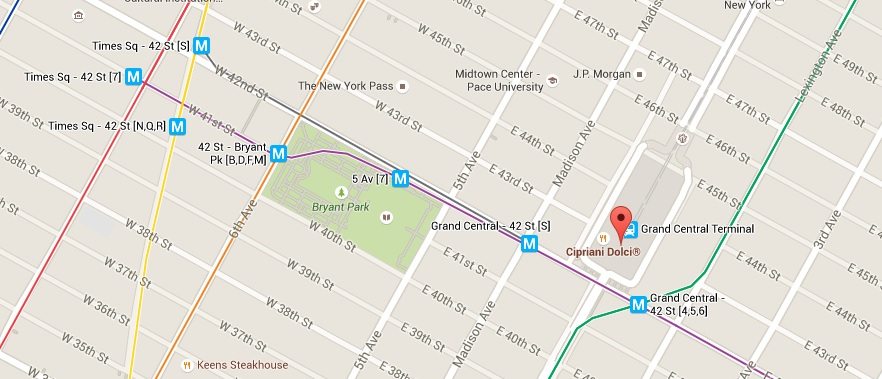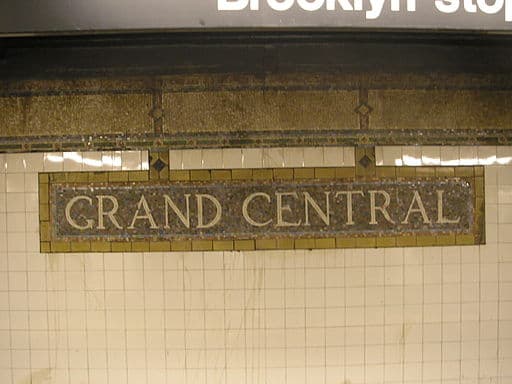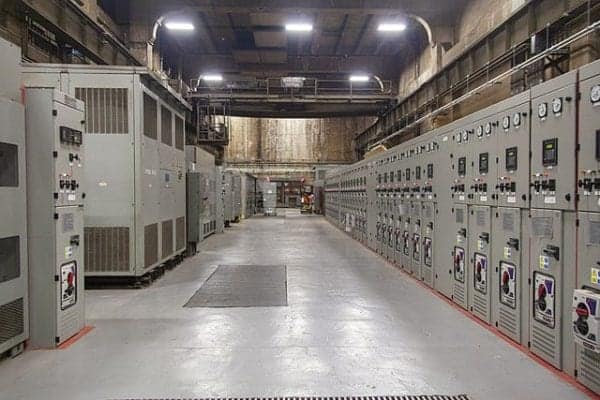This post is a guide to Grand Central Terminal, what you can see here, tours, dining, shopping, and secret locations. (Guia en español)
All aboard!
- How to Get Here
- What to See
- Tours
- History
- Shopping and Dining
- Secrets of Grand Central
- Grand Central Station (or Terminal)?
WHERE IS GRAND CENTRAL TERMINAL?
Grand Central Station is located at 42nd Street and Park Avenue (map).
It can be also accessed from Lexington Avenue on the East, Vanderbilt Avenue on the West and 46th Street on the North.
Getting there:
As one of the busiest subway and train hubs in the world, multiple subway lines serve the station.
By subway:
- 4, 5, 6, and 7 trains to station stop Grand Central-42nd Street
- S shuttle train that runs between Times Square and Grand Central
If you are new to the NYC Subway, then be sure to read the following guides.
By bus:
M42, M101, M102, M103, M1, M2, M3, M4, and Q32
TIP: Hop-on-hop-off buses all have stops very near Grand Central, so why not consider a tour bus as a fun means of transportation around the city, and hop-off to check out Grand Central along the way!
Hours:
The subway 5:00 am - 2:00 am (the subways run to this stop 24 hours a day, but the terminal building itself closes for a few hours each morning.)
Practical Tips:
If you need to store your luggage before departure or after arrival, check out these options for luggage storage near the terminal as there are no longer lockers available.
Nearby Attractions
Due to its Midtown location, the terminal is located near several popular attractions, including:
- Empire State Building
- Times Square
- Bryant Park
- New York Public Library
- Rockefeller Center
- St. Patrick's Cathedral
- United Nations
WHAT TO SEE AT GRAND CENTRAL
Grand Central is one of the most beautiful structures in New York City. It is one of the very best locations for iconic New York City photography, so have your camera ready to go as you visit the sights below!
Exterior
Start on the outside of the Terminal. Look all the way up to the top of the building where you will see a cluster of sculptures.
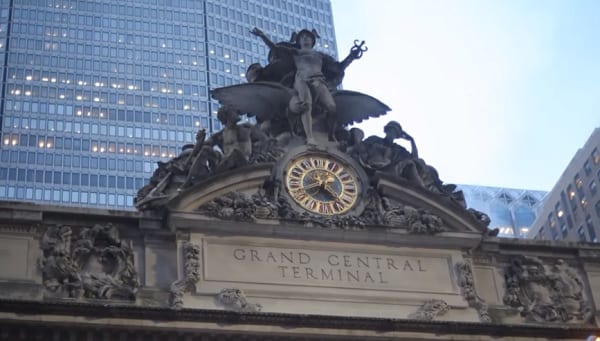
This collection was designed by Jules Felix-Coutan and depicts Minerva, Mercury, and Hercules.
This represents Wisdom, Speed, and Strength, according to Roman mythology.
When it was unveiled it was the largest sculpture grouping in the world and it was called “The Glory of Commerce.”
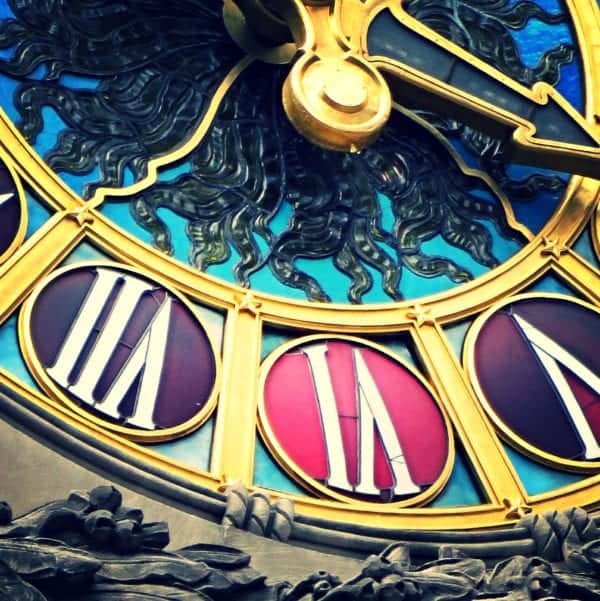
Just beneath Mercury is the exterior clock of Grand Central. It is the largest piece of Tiffany glass in the world, measuring 14 feet in diameter.
This clock is also the only one that is a part of the station is set to the correct time, but more on that later!
Look for the eagles perched on the corner of the building. These eagles actually adorned the previous Grand Central Station, which opened in 1869.
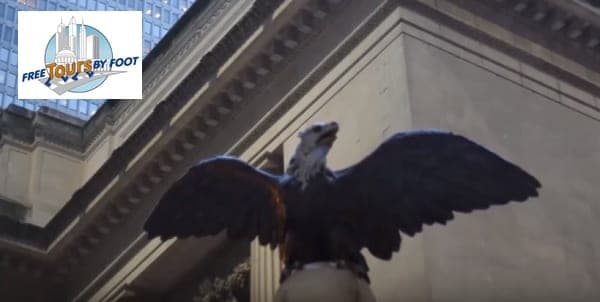
These eagles have very lifelike and ferocious expressions on their faces. This helps to keep pigeons away.
The statue out in front is The Commodore or Cornelius Vanderbilt. The Commodore was the man that started it all by unifying the railroads at Grand Central Depot.
The Vanderbilt family also built the current Grand Central Terminal.
Consider using our audio tour to guide you through the terminal.
INTERIOR
Main Concourse
The Main Concourse is the center of activity in the terminal, with people rushing through the massive, 275 ft-long space trying to catch their trains.
It is also one of the most beautiful train terminals in the world.
Plan to spend some time here and admire the splendor, though best to avoid during rush hours (8-9 am and 5-6 pm).
You may recognize the Main Concourse from dozens of films, from Hitchcock’s North by Northwest to the animated film Madagascar.
Superhero fans will certainly recognize the terminal from the Avengers, Superman, and X-men. Check out our Superhero Tour of New York City.
The Ceiling
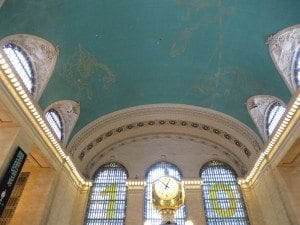
This is probably the best-known part of Grand Central. It depicts the constellations of the zodiac.
Though it is beautiful, the ceiling is not astronomically correct. It is actually backward.
This was pointed out by an astute commuter in 1913.
This error was explained away with the reason that it was painted to reflect the perspective of God looking down, in keeping with medieval artistic traditions.
Many think that it was not intentional and that the sketch provided by Columbia astronomer Harold Jacoby for the painting of the ceiling was simply misread and done backward by careless painters.
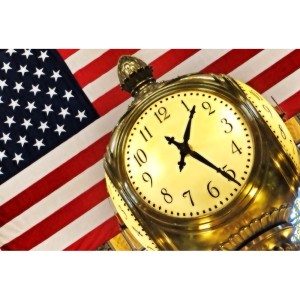
The Clock
The four-sided clock is possibly the most iconic feature of Grand Central. The clock has been a long-standing meeting spot for New Yorkers.
The clock is made of brass and it is said that the clock faces are made out of precious opals and that the value of the clock is well over $10 million!
Also, if you take a look at the clock and then a quick peek at your phone or watch, you will notice that the time on the Grand Central clock is a minute or so ahead.
This is on purpose and is consistent with every clock inside the station. The clock helps people to not be late for their trains and prevents safety hazards with people running for trains that are about to pull out of the station.
Some fun trivia: In the movie Madagascar, Melman the giraffe breaks the clock while the animals are in the station trying to catch a train to Connecticut.
Ceiling Smudge
look all the way over to Cancer the Crab in the northwest corner of the ceiling. Just past that, where the blue and white meet, there is a small blackish rectangle.
That is just how filthy the original beautiful sky-blue ceiling had become after decades of accumulated tar and nicotine smoke.
There were a great many smokers among the nearly half-million people who passed through the terminal every day since its opening.
Over time the ceiling became coated with thick grime which was finally removed in 1998 when the terminal underwent a massive restoration spearheaded by Jackie Kenndey and other preservationists.
Workers got up on the scaffolding with buckets of soap and water and paintbrushes and cleaned away the years of build-up.
The one spot was left as a reminder of how much work was done.
The missile was very big, so in order to not disturb pedestrian traffic flows, a hole was made in the ceiling so that the rocket could be suspended above the floor.
It was left as a testament to all of the different eras of history that Grand Central has seen.
Carvings of acorns and oak leaves
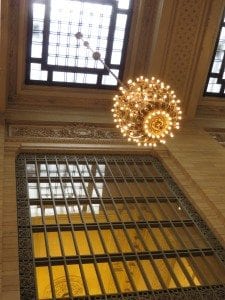
Keep an eye out all throughout the station for carvings of acorns and oak leaves. They are everywhere!
That is because Cornelius Vanderbilt chose them as a family symbol. The family motto was “Great oaks from tiny acorns grow”.
Vanderbilt was a self-made man and that symbolism resonated with him. There are carvings all over the Terminal; some large, some small.
The easiest to spot are on the bottoms of the beautiful 24-carat gold-plated chandeliers, which have 110 light bulbs each!
The Biltmore Room
The Biltmore Room is also known as "The Kissing Room."
In the height of train travel for long-distance trips, the famous 20th Century Limited train from the west coast arrived at the tracks next to the Biltmore Room.
Passengers, sometimes including movie stars and politicians, would exit the train and reunite with their loved ones in the Biltmore Room.
There was much hugging and kissing, hence the nickname "The Kissing Room."
While you are in here, check out the back wall. On it, you will see a chalkboard, a relic from the early days of Grand Central.
Before automated boards, it was someone's job to sit there and hand-write the arrivals and departures on the chalkboard.
This was no easy task because, in the heyday of Grand Central, there were over 550 departures every weekday. (There are usually 286 today.) That's a lot to keep up with!
The Whispering Gallery (right outside the Oyster Bar)
One of the most popular spots in the Terminal, the Whispering Gallery is often crowded with people who have their faces pressed into the corner.
This relatively plain-looking space can do something amazing.
The gallery transmits sound from corner to corner perfectly, so that you can have a conversation with a friend at the barest whisper and hear each other as though you were standing face to face.
This architectural anomaly is caused by the precise arch of the ceiling and the tiled surface. Don’t miss this! Click here for a 45 second YouTube video demonstration.
For the most in-depth exploration of this building, sign up for one of our free Grand Central Tours! If you are going to visit on your own, use this post as a guide.
GRAND CENTRAL STATION TOURS
This building is chock-full of amazing history, details, and quirks. Whether you take a tour or explore on your own, do not miss this gem of NYC.
Free Tours by Foot audio tour with GPS, perfect for any time, day or night. A download is just $1.99. Below is a sample.
Free Tours by Foot also offers a two-hour tour of Grand Central on Sundays at 10 am and sometimes at 1 pm.
The Grand Central Partnership offers a free (donations accepted) tour every Friday @ 12:30 pm.
The Municipal Arts Society offers daily at 12:30 pm, 75-minute tours of the terminal. Tickets are $25 for adults and $20 for seniors, students, children under 10, members of the military. Space is limited.
TIP: If you have the New York Pass, the audio tour of Grand Central Terminal is included.
Not sure if a tourist pass is for you? Then check out our post Which New York Tourist Pass is Best?
What is the difference between Grand Central Terminal and Grand Central Station?
The difference is that the commuter trains that service the suburbs of NYC start and terminate at Grand Central, thus it is a terminus for these trains (hence Grand Central Terminal).
Technically, there is also a station is for subway trains. These trains don't terminate here, they pass through (hence the name Grand Central Station).
Most people call the combined units Grand Central Station even though this is a misnomer.
Part of the confusion stems from the history of train use in this area.
The first structure built there in 1871 was Grand Central Depot and was a hub for railroad lines that came through Manhattan.
As the use of railroads grew, the depot was demolished in 1899 and a larger structure was built.
It was called Grand Central Station as railroad lines passed through the site and did not necessarily terminate there.
Once railroads ceased servicing New York City, all railroad lines coming into the city terminated at the station, and the name of the structure changed to Grand Central Terminal.
HISTORY OF GRAND CENTRAL
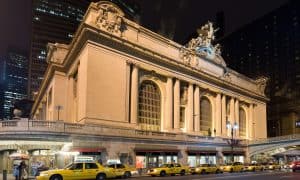
The current Grand Central Terminal was opened on February 2, 1913.
Prior to the opening of this beautiful, Beaux-Arts building, there were two previous stations on this site: Grand Central Depot and Grand Central Station.
The previous buildings served to unite all of the existing rail lines in New York at the time and to bring them all under one roof.
From 1903 to 1913, Grand Central Station was systematically torn down and the current Grand Central Terminal was built in its place.
The architectural firms of Reed and Stem and Warren and Wetmore designed the massive granite building.
The station was considered revolutionary in many ways. The station was electric, bi-level and the tracks were below ground.
This novel scheme made for more efficient rail traffic and also opened up Park Avenue north of Grand Central, which had previously been covered by rail tracks.
Over 150,000 people turned up to celebrate the opening day of Grand Central Terminal, and it had been drawing crowds ever since!
SHOPPING AND DINING
What Shops are at Grand Central Terminal?
Grand Central Terminal (GCT) has a variety of shops that cater to both commuters and tourists.
Many shops sell upscale clothing, accessories, jewelry, and other items that appeal to tourists and also commuters from the wealthy suburbs.
You’ll find stores like Vince Camuto clothing, Jo Malone fragrances, and TUMI Luggage.
Other shops aren’t as fancy and sell practical items, including a pharmacy, several beauty supply shops, a nice wine store, and more.
Top 10 shops we think visitors to NYC will enjoy:
- Apple Store - shop, just recharge your phone and surf the web for free
- Banana Republic - men’s and women’s clothing
- Warby Parker - trendy and affordable eyeglasses
- PIQ - designer toys, unique NYC items, clever books
- New York Transit Museum Gallery Annex & Store - NYC souvenirs
- Swatch - fun and funky watches
- L’Occitane - France-based chain selling skincare, bath & hair products
- Li-Lac Chocolates handmade chocolates & other confections
- Papyrus - fanciful paper goods, accessories, and gifts
- Kidding Around Toys - independent toy shop with an educational slant
Save some money by taking advantage of the monthly deals and offers at the Grand Central shops and restaurants.
TIP: If you are here during the holiday seasons, visit the Grand Central Station Holiday Market.
Top 10 Places to Get Food
There are dozens of places to get food inside of Grand Central. Most are affordable and perfect for grabbing lunch or a snack.
Many are located in the Dining Concourse on the lower level of the terminal.
Here is a map of the dining concourse and a directory of food shops.
- Prova Pizzabar
- Grand Central Market
- Doughnut Plant
- Murray’s Cheese
- Shake Shack
- Great Northern Food Hall
- Shiro of Japan
- La Chula
- Dishes At Home
- Magnolia Bakery (of Sex and The City cupcake fame!)
There are also some fine dining, like Cipriani Dolci, where you can dine on the second level balconies of the Grand Hall and watch as people pass through the terminal.
The Oyster Bar
The famous Oyster Bar is the only business that remains from the very day that Grand Central opened in 1913.
They offer one of the largest seafood menus in the city, with over 25 kinds of fish and over 30 different kinds of oysters.
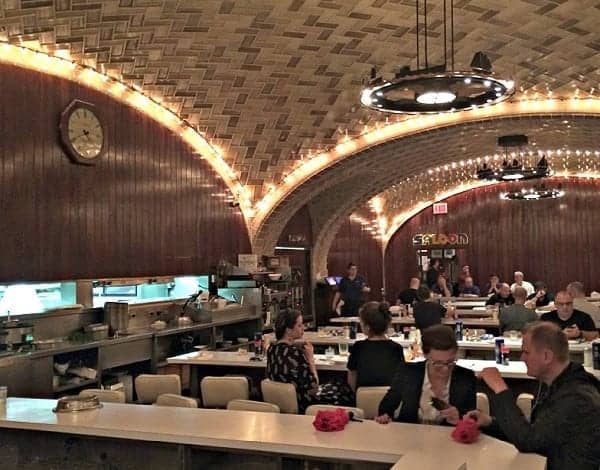
They just underwent a renovation, so stop by and check it out!
While you are slurping oysters, be sure to look up and check out the beautiful Guastavino tile ceiling.
The Oyster Bar is shown in the current opening of Saturday Night Live, as a background while they are introducing cast members.
Campbell Apartment Bar
Grand Central’s “hidden” bar can be accessed from the Vanderbilt Avenue side of the station.
Despite the name, it was never actually a residence. The Campbell Apartment was the private office of railroad executive John W. Campbell in the 1920s.
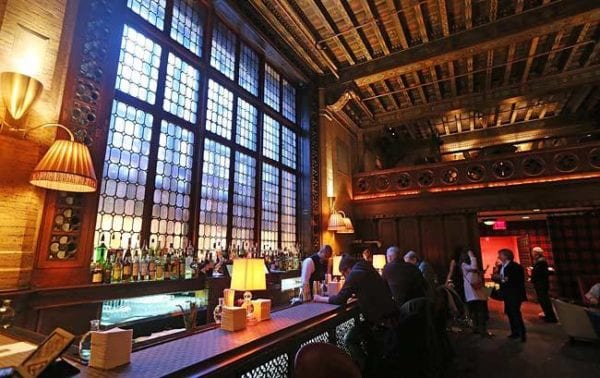
Campbell leased this large, 30ft by 60ft space from the Vanderbilt family. He then paid to have the place transformed into a 13th century Florentine Palace.
He had a safe built into a faux-fireplace and ordered a Persian rug that took up the entire floor. The rug alone cost $300,000 in the 1920s (as much as $3.5 million today!)
Campbell also had a pipe organ installed and bought a grand piano for the office.
In the evenings he used it as a private reception hall, entertaining up to 60 guests and hiring world-class musicians to come and play private recitals. T
here was a permanent butler on staff named Stackhouse.
After Campbell’s death in 1957, the office became a relic of a bygone era and became first a signalman’s office, then a storage space and then finally a small jail for the Transit Police.
The Campbell Apartment was restored to its former glory in 1999 and opened as a bar.
Drinks are not cheap, but it is a fantastic experience and truly feels as though you have stepped back in time.
SECRETS OF GRAND CENTRAL
M42
M42 is the most closely guarded secret of the station. The room is not shown on any map or blueprint and its existence was not even acknowledged for many years.
It contains a massive converter that is responsible for all of the electricity in Grand Central, including the rail tracks.
It is such an important room that it was the target of an important German spy mission during World War II.
Two German spies attempted to debilitate the rotary motors, which would have cut off the power grid.
Because we moved troops by train in the 1940s, this would have halted troop movement on the Eastern Seaboard and would have been a major setback.
The men were arrested before they could carry out their plan, and M42 is still a closely guarded secret.
Track 61
Track 61, a part is Grand Central, is underneath the Waldorf-Astoria hotel. It can be reached by a private elevator car that goes directly from the Presidential Suite down to the platform.
President Franklin Delano Roosevelt used it often because he disliked being seen in public in his wheelchair.
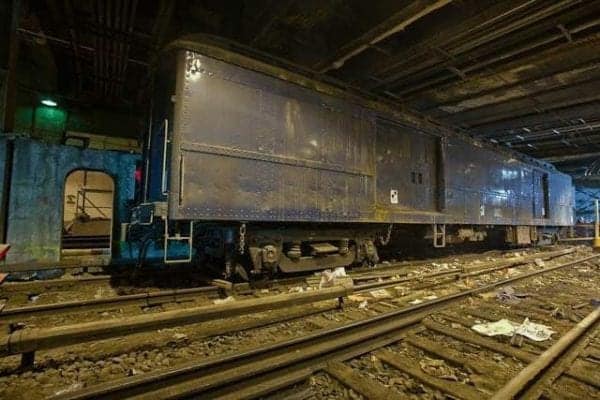
Using this platform made it possible for him to travel out of the public eye.
In later years, the platform was a fashionable (if bizarre) event space. Andy Warhol held a party on the platform and a fashion show has been held there.
Though it isn’t used regularly anymore it could technically be accessed from the Waldorf Astoria in the event of an emergency if someone needed to get out of New York quickly and discreetly.
Tennis Court
Yes, you read that right! There is a tennis court in Grand Central, added in the 1960s.
It is currently owned by Donald Trump and is called The Vanderbilt Tennis Club.
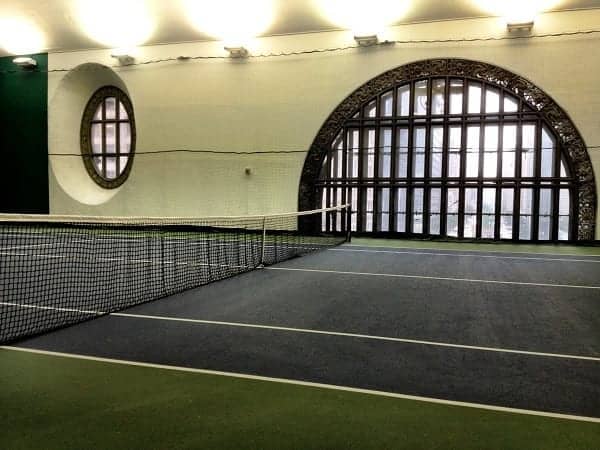
Superstars such as the Williams sisters have played there. Technically it is open to the public, but most people would have a tough time getting a reservation!






